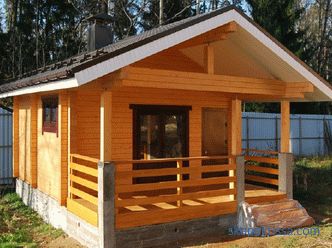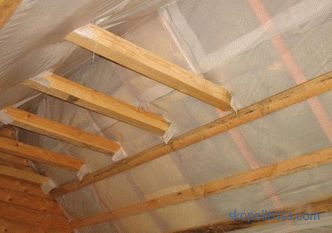A septic tank is a good method for creating a modern sewage system. It collects wastewater, settling and processing, solids settle to the bottom of the tank, and clarified drains are discharged for further purification. Considering the fact that cleaning the drains in the septic tank itself is not sufficient, additional cleaning is required, for which a drainage system is installed for the septic tank.
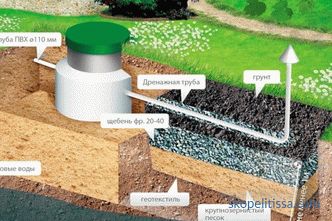
Arrangement is carried out by two methods:
-
production of a filtration well;
-
organization of the drainage field.
The most common method is the latter.
Types of drainage structures
There are two main drainage systems:
-
Drainage well for a septic tank. Drainage wells, which are used if the soil and flood waters have a deep occurrence. The device is an ordinary well, which has no bottom. In order to create such designs apply rings made of reinforced concrete. Now they are applied much less frequently.
-
Filtration field for septic tank. This type of drainage applies when groundwater is high. This design includes special pipelines, which are located in the upper soil layers. The performance of the device depends on the length of the pipelines. The area of the entire assembled structure may be several hundred square meters.
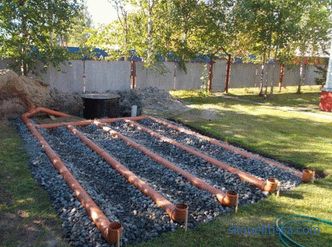
The functioning of the drainage part of the septic tank
How and any device, a drainage field for a septic tank functions according to a certain principle:
-
Obtaining clarified drains from the septic tank.
-
Distribution of runoff by land area.
-
Passing through a cushion of rubble, the drains are finally cleaned and the clarified water goes into the ground.
In addition, in some cases, clarified water is discharged into a specially designed septic tank.
With proper arrangement of the filtration field, the effluent is brightened by another 30%, which makes environmental threats less dangerous.
The basis of the filtration field is the aerobic method of the cleaning process. The drains that come from the septic tank are cleaned by the air in the system.
With the help of air, organic compounds that are contained in the effluent are decomposed into elements. These elements do not pose an environmental threat.
Device Diagram
The Drainage Scheme is a design drawing showing the main features of the entire device.
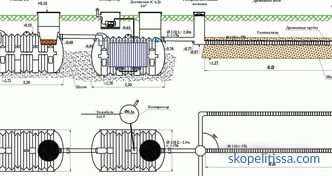
On our site you can find contacts of construction companies that offer the installation of water supply and sewage. Directly to communicate with representatives, you can visit the exhibition of houses "Low-rise Country".
The scheme includes the following components:
-
field location relative to the septic tank, as well as other devices that are on the land;
-
dimensions of this filtration structure;
-
dimensions and number of open excavations in the ground (trench);
-
length and diameter of pipes, their parameters slope;
-
information about the products used to mount the pipe cushion, this also includes the thickness of each specific layer;
-
pipe installation places that are intended for ventilation;
-
place of clarified water.
The location of the drainage field should be no closer than 30 meters from any water sources. Such a source could be, for example, a well. The design of the septic tank should also be located on the garden or vegetable garden on three meters.
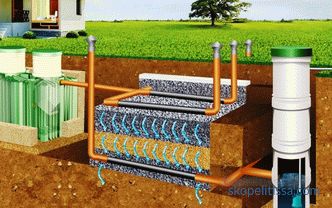
Size of the sizes the field itself, the length and number of trenches depends on the volume of the septic tank and the estimated speed of wastewater treatment. In addition, these parameters are influenced by the characteristics of the soil layer.
If the ground is sandy, then one meter of pipe can be “loaded” with 30 liters of waste per day. If the soil is sandy, this figure is halved.
The loamy soil absorbs less water, so the pipe is lengthened.
Calculation of the depth of excavation in the soil is carried out taking into account the fact that the bottom should be located above one meter from the groundwater. Most often, the trench depth is two meters. The width of the notch depends on the number of pipes and can be from 5 to 10 meters.
Perforated pipes that have an average diameter of 12 centimeters are most commonly used for installation.
How to choose pipes for a drainage septic tank:
All drainage pipes for a drainage field of a septic tank should have an equal pitch of 1 meter slope is 1.5 centimeters. Every 6 meters is the establishment of a tower, designed for ventilation.
Sand, with a fraction of up to 10 millimeters, and crushed stone with a fraction of 30 millimeters, is used for laying pipelines. In addition, geosynthetics are used, namely geotextiles, which are intended for the thermal insulation of pipelines. The material provides additional purification of water waste.
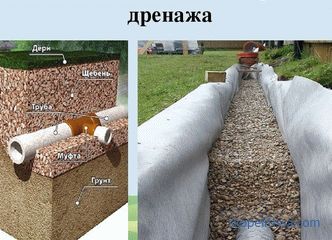
It can be interesting! In the article on the following link read about the device of drainage pipes.
Installation Algorithm
The procedure for installing an aeration field is as follows:
-
First, the place where the aeration field will be located is determined.
-
A trench of necessary depth and width is dug out.
-
Next, a ten centimeter soil layer is laid, which has excellent throughput.
-
Backfilling of rubble with a fraction of 30 millimeters. The thickness of the layer should be 35 centimeters. Drainage pipes go deep into it. The length of the pipes is no more than 25 meters.
-
Attach pipes to the septic tank and risers for ventilation, which are approximately 50 centimeters high. Ventilation towers are equipped with special umbrellas for protection. Slope - 1.5 centimeters per meter.
-
Poured on the top layer of crushed stone 10 centimeters thick.
-
Geotextiles are laid from the top of the pipes. It is necessary for pipe insulation.
-
From the upper part, the ground layer is laid, having a height of 30 centimeters.
The algorithm is suitable for sandy and sandy sandy soil cover; for a clayey soil layer, more serious filling of the bottom of the excavation is carried out. The soil that is used to backfill the dredging should have excellent water carrying capacity. The height in this situation is 70 centimeters.
Dosing chamber
In order to ensure a uniform flow of wastewater at the outlet of the septic tank, a dosing chamber is created.
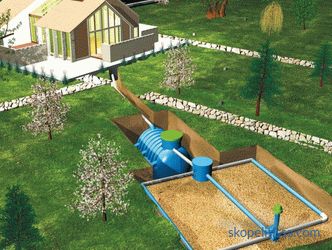
The dosing chamber is a capacity that has a capacity of up to 1 cu. /meter. For the construction can be used finished container of plastic, corresponding to the required volume.
The bottom of the excavation is aligned where the container is loaded to. Uninterrupted operation of the system at the outlet of the tank is achieved by installing a siphon, which has a diameter of 100 millimeters and a knee height of 200 millimeters. As soon as the siphon is filled, it will self-charge, then self-inflate. Due to this, the purified liquid is fed into the pipelines for distribution.
It might be interesting! In the article on the following link read about the drainage pump for sewage.
Drainage tunnels
Drainage tunnels are a type of filtration field. This design is chosen in the event that discharges a huge amount of water flows. A distinctive feature of the device is an enlarged section, which provides a high cleaning rate. Plus drainage tunnels - a high level of mechanical stability, which makes it possible to perform the installation of after-treatment field, which can be located even under the car park.
Construction installation algorithm:
-
Trenching up to two meters. At the bottom of the excavation, a sand "cushion" is created, having a thickness of 50 centimeters. From the top there will be a layer of crushed stone 30 centimeters thick.
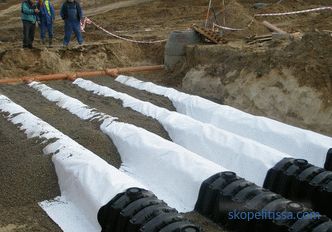
-
installation of . Before installing the surface must be leveled and tamped. The outer walls of the modules are covered with geosynthetics.
-
Elements are connected. A connection is made to the branches of the structures to the outlets from the septic tank.
-
Mounting ventilation . In the openings of the facilities, installation of the leads for ventilation is carried out.
Geogrids are also installed to evenly distribute the loads over the structures.
Example of a drainage field device:
The mounting technology is practically no different from the design of a standard filtration field, which consists of perforated pipes.
It might be interesting! In the article on the following link read about the drainage pipe.
Conclusion
The autonomous sewage system, consisting of a septic tank and a drainage field, is an efficient and budgetary system that is sufficiently efficient for the treatment of wastewater. But we must remember that in a new place the septic tank should be equipped with special care - if you do not comply with the technology, then it can nullify all the work done, so only experienced specialists who guarantee their work should be trusted to install the septic tanks.

